#what even is the ship name for Mary x Irene
Explore tagged Tumblr posts
Text
@bbcmary has figured out how to Irene’s weakness and ways to bribe/tempt Irene; fresh baked cookies
#Mary always has cookies around for this reason#I swear#All our threads have cookies at some point and idk why#so#Mary keeps cookies around in case Irene shows up#Shhhhhhhh#what even is the ship name for Mary x Irene#She who speaks Lies [Mary Watson]#The Woman who Mattered [Irene Adler]#Mary x Irene
1 note
·
View note
Text
Little Witch Academia/Luca AU
Hey everyone, back again with a quick AU idea! So, you know that new Pixar movie Luca, of course you do, its been advertised everywhere lately~! Well, hearing that it takes place in Italy immediately got me thinking, "Hm, what if the Italian Witches of Luna Nova Academy were also the sea monsters from Luca?". And thus, this cute little AU was born~! Also, if you didn't know, yeah, Croix isn't the only Italian Witch in Luna Nova. There's also Bianca, Irene, and even Blair. Which is funny, since this means that Croix is the only not blonde Italian Witch in Luna Nova, lmao! And just like in the movie, they keep it a secret from almost everybody, with very few knowing their true forms.
This AU is also pretty shipping heavy, because I'm kinda obsessed with shipping. So yeah, this is probably a good a time as any to introduce some ships involving the background witches~! The ships this AU focuses on are ships involving the Italian Witches obviously, with some other ships being mentioned in passing. The ships being focused on are Bianca x Aileen, Sucy x Irene, Ursula/Chariot x Croix, and Andrew x Blair. The ships mentioned being Akko x Diana, Avery x Mary, Lotte x Barbara, and Amanda x Hannah. Don't worry, if I ever do more with this AU, I promise not to make it too ship heavy. I just really wanna do stuff involving ships I adore
Also, for just simply for the sake of showing off, I'm gonna share some ideas I shared with my friends on Discord, because why the fuck not?
For Bianca and Aileen, I kinda like the idea of Bianca keeping it hidden from everyone, until she and Aileen get wet for some reason, and her secret is found out. Now, the two are alone, but that doesn't stop Bianca from freaking out big time. She starts crying, thinking Aileen will hate her now, but all Aileen does is stare, and then lunges at her for a hug once she registers that Bianca is crying. Aileen comforts her and tells her its okay. Bianca then cries tears of joy as the two kiss.
For Sucy and Irene, I can see Irene straight up telling and showing Sucy she's a sea monster, since, well, its Sucy we're talking about. But, now she has to deal with Sucy wondering what kind of sea potions sea monsters can make, or how their scales work in potions. Well, that's Irene's fault, and now she has to pay the consequences.
(Note: One of my friends on Discord actually thought of the Sucy potion thing on his own.)
For Ursula and Croix, I can see Chariot knowing that Croix was a sea monster since they were students. And her keeping that secret, with the only other person knowing is Akko. Akko found out by accident, but Chariot and Croix made sure to tell her the full story so she didn't out. But surprisingly, Akko takes rather, to the point that Croix sprays water in her face to make she isn't some kind of Japanese sea monster in secret. She isn't, and Akko promises to keep it a secret. She actually likes the fact that Croix is a sea monster, to the point where Ursula and start making hypotheses as to why. Most come down to, Akko's just a weird kid!
For Blair, its pretty simple. I can see her wanting to tell Andrew she is a sea monster, thinking that doing this will strengthen their relationship, or at least her delusional idea of her relationship with Andrew, who doesn't even know her. She thinks this'll show trust and respect in their relationship, showing that there are no secrets between the two and that Andrew can be trustful of her. Blair loves, thinking that Andrew will love her honesty and willingness to really forward with him, and to share such a big secret just for him. But, the other Italian Witches have to drive some sense into her, and remind her that Andrew will more than likely freak out that a complete stranger he probably saw only once was a sea monster the whole time. And how this could put her and the others in potential danger. But does Blair listen to them? No, hell no! She's a lovestruck hopeless romantic, you really think her heart follows things like logic, common sense, knowledge, or even basic as hell thinking? Not when she wants the D, that's for sure.
So yeah, that's my AU for now. Not much else to say, but, uh, fish puns? Whatever, goodbye.
(Also, apparently some people thought Croix was French, just because her name is more French than Italian! Nothing else here, I just really wanted to point that out since I thought that was like really funny to me~!)
#little witch academia#lwa#bianca#lwa bianca#croix meridies#croix#irene#lwa irene#blair#lwa blair#aileen#lwa aileen#ursula#chariot#ursula callistis#chariot du nord#sucy manbavaran#sucy#andrew hanbridge#andrew#atsuko akko kagari#atsuko kagari#atsuko#akko kagari#akko#luca#luca pixar#au#lwa au#shiny chariot
19 notes
·
View notes
Text
THE KNIGHT OF BASKERVILLE
________________________________________________________________
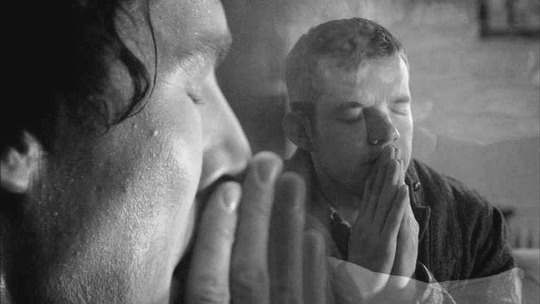
ACDs novel The Hound of the Baskervilles tells the story of Sir Henry Baskerville who returns from Canada to take up the inheritance of his family, the Baskerville estate with the old manor house Baskerville Hall.
The Sherlock BBC adaptation, The Hounds of Baskerville, transforms the centuries old manor house into the modern high-security military base BASKERVILLE, supervised by the britisch government. Because the character ‘Sir Henry Baskerville’ had to be included as well, it’s understandable that a renaming of this important character became necessary.
But why Henry KNIGHT? Names are important in Sherlock BBC. Reason enough to take a closer look at the name and significance of ‘knight’.
TBC below the cut ….
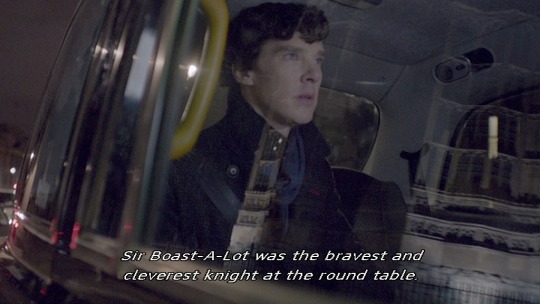
What’s a knight?
- Nowadays, a knight is a person who has been given a rank of honour by the Queen or King of GB because of special achievements
- In the past a knight was a man of high social position, trained to fight as soldier on a horse for his liege lord
- In myths, legends and fairytales knights are often depicted as brave and valiant men who fight against all kinds of evil forces. They defend not only their king or queen, they often become ‘a last refuge for the desperate, the unloved, the persecuted … a final court of appeal for everyone‘. They stand up for justice and fight for those who aren’t able to help themselves.

Knights and pirates
Mycroft mentions in ASIB that his little brother Sherlock initially wanted to be a pirate. In TFP, right after Sherlock jumps through fire and flames onto a ship which will bring him to Sherrinford, he calls himself a pirate. Are there connections between pirates and knights? Of course there are:
One of the most famous pirates of the British Empire was Sir Francis Drake -Elizabeth I awarded Drake a knighthood in 1581 which he received on his ship, the Golden Hind.
William Knight was a 17th-century English buccaneer (pirate). Reading the Wikipedia entry about him, it looks like ‘Captain Knight’ has indeed raided ‘the seven seas’.
William Sherlock Scott Holmes, consulting private detective, the only one in the world and additionally dragon slayer, pirate and knight …. this man really loves to be dramatic.
(For more delicious pirate treats look up this post about Sherlock and the Pirates of the Caribbean, black spots and Treasure Island)
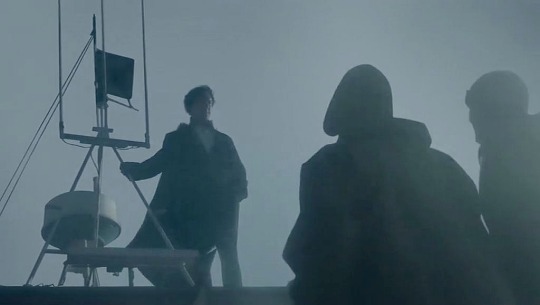
Knights are guardians, defenders, soldiers ... pirates ... who slay the most dangerous dragons and save damsels in distress …
(With every quiver of his beating heart The Black Defender).
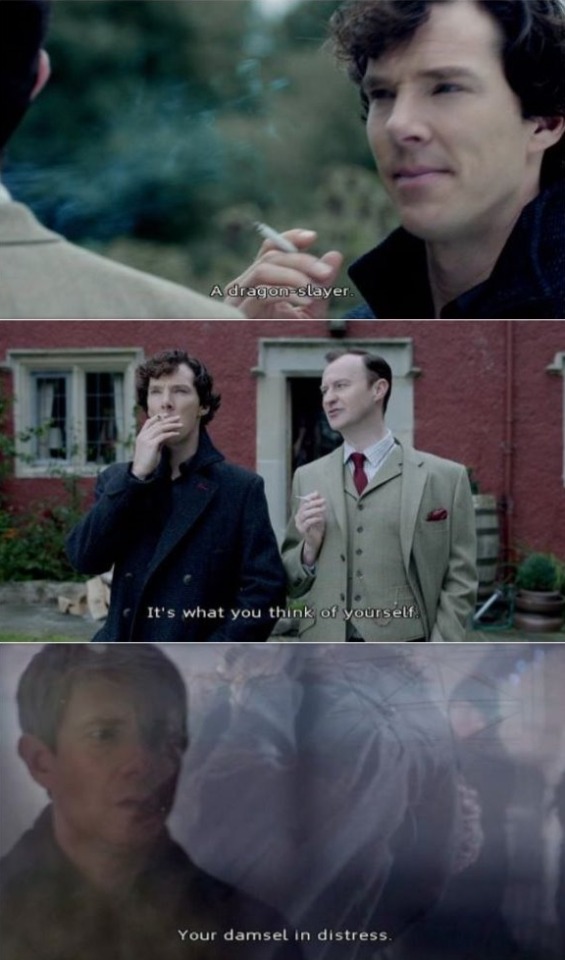
Two ‘damsels’ in Sherlock BBC
A damsel - is an old fashioned term, meaning a young woman, often unmarried and of noble birth. Synonyms are: demoiselle, girl, maid, maiden, miss. The word comes from the Middle English damesel, from Anglo-French dameisele, from Vulgar Latin domnicella (young noblewoman), diminutive of Latin ... domina lady (x)
‘Damsel’ appears two times in Sherlock BBC in two different scenes from two different episodes. It is used by two different characters and aimed at two different persons.
Mycroft in ASIB talks about Sherlock and ‘dominatrix’ Irene Adler:
That’s all it takes: one lonely naïve man desperate to show off, and a woman clever enough to make him feel special. …. The damsel in distress. In the end, are you really so obvious? Because this was textbook: the promise of love, the pain of loss, the joy of redemption; then give him a puzzle … and watch him dance.
Magnussen in HLV talks about Sherlock and ‘eternal friend’ John Watson:
Very hard to find a pressure point on you, Mr. Holmes. The drugs thing I never believed for a moment. Anyway, you wouldn’t care if it was exposed, would you? But look how you care about John Watson. Your damsel in distress.
What an interesting combination of characters on both sides of Sherlock. And one more confrontation of the two (so often hinted at) opposites in this story - sex and friendship (Solutions or choices). Irene and Jim represent the female and male incarnation of sex, while John-I’m not gay-Watson represents the ‘eternal’ friend and fixed point in a changing age. Both aspects - sex and friendship - are called Sherlock’s ‘damsels’. And it’s even more interesting to see who makes those statements:
MYCROFT - owner of a laptop on which depends the security of the free world (”with potatoes on it - shelves in exchange for chips - I am glad you liked my potatoe - you’re suicidal, you’re allowed chips”)
MAGNUSSEN - who runs the western world from a library of secrets and scandals that isn’t stored on computers but on hard copy in vaults
A computer versus hard copies in vaults … Well, this reminds me of Sherlock’s explanation in The Great Game, regarding his brain. He compares it to a computer hard drive and adds that ‘it only makes sense to put things in there that are useful ... really useful. Ordinary people fill their heads with all kinds of rubbish, and that makes it hard to get at the stuff that matters?‘ And what might be a ‘hard copy in vaults’? This seems to be a perfect metaphor for informations stored inside the brain. That organ occupies the space in the skull called ... cranial vault.
(Mycroft & Magnussen A shadow of massive proportions)
A computer versus hard copies in vaults … two paraphrases for one and the same thing … a brain. Janus-faced, one could call it. A mind in conflict with itself. Time to choose a side for Sherlock Holmes. Friendship or sex? John or James? Saint or sinner?
What if Sherlock chooses neither? ‘I could just walk out of here’ (and carry on torturing myself in an isolated dungeon, locked up in solitary confinement with my worst enemy, that’s ME by the way, for another couple of centuries … I can’t die anyway, I’m an immortal literal character ... an undead)
What if Sherlock chooses both? A tempting idea …. :)))
A game for the brain
Chess is called the ‘game of kings’ (’Am I the current king of England?’) and chess plays a vital role in Sherlock BBC. Serial killer Jeff Hope compares the game he wants to play with Sherlock to chess … ‘it’s chess not chance’. There’s a chess board in 221b, the pieces are always standing on it, ready to play. It turns up in each episode, placed at different locations in the living room. The third episode of S1 is called The Great Game. A fake chess game in TEH. A game of chess in Tiblisi, Georgia between two massive lion statues. And let’s not forget the three mysterious promo pics for S4 … Sherlock and Mycroft playing chess and John sitting between them. There are no visual connections whatsoever in S4 to those pics. Anyway, chess is important … especially one certain piece type of the figurines, it seems.

Chess is a very old two-player strategy board game, originating from India around the 6th century. The oldest archaeological chess artifacts were excavated in Uzbekistan, central Asia, and date to about 760. Chess is played on a checkered board with 64 squares arranged in an 8×8 grid, with16 pieces for each player:
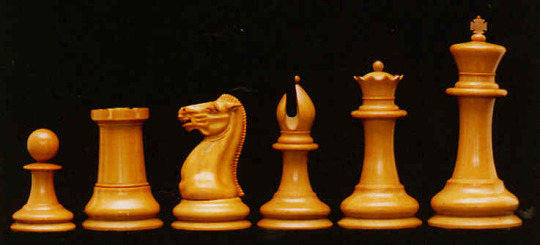
One king, one queen, two rooks, two knights, two bishops, and eight pawns. Each piece type moves differently and ... these are the moves:

The knight is a specialist ...
The chess piece called ‘knight’ is normally represented by a horse's head and neck. The area a knight is able to cover - to protect or threaten other pieces - forms a circle.
The knight moves unconventionally compared to all the other chess pieces. Whereas other pieces move in straight lines, knights move in an “L-shape”—that is, they can move two squares in any direction vertically followed by one square horizontally, or two squares in any direction horizontally followed by one square vertically …. a bit similar to the strange sitting arrangement of Sherlock and John, chosen for the plane scene in TST.
Presumed both men were knights on a chess board, each move of either man could bring him to the place of the other one. Mary isn’t in the way at all because knights are able to …. jump.

The ‘jumper’
Another characteristic feature of a knight is the fact that it is the only piece in the game of chess that can “jump over” other pieces, regardless of whether those pieces are black or white. Because of this, some languages refer to the knight as ‘the jumper’ (in german ‘der Springer’).
Of jumping and jumpers
Jumping in front of trains, of ‘transport’ and leaving behind strawberry jam, connects the Andrew West case from TGG with the Strawb-Fizz-Explosive-Flavour-Bus from TST, in which John meets E (Eurus/Sherlock). A quite explosive meeting indeed, thinking of Eurus’ passions grenade a little later.
(Bus spotted on and speculated about during setlock, in the night-shot with Faith 12.06.2016 x x)

Jumping from a rooftop, taking a leap of faith from the edge of a waterfall, throwing oneself through fire and flames out of windows onto an island ..... jumping, falling, flying and landing …. those are definitely main topics in Sherlock BBC. (Developement of the fall)
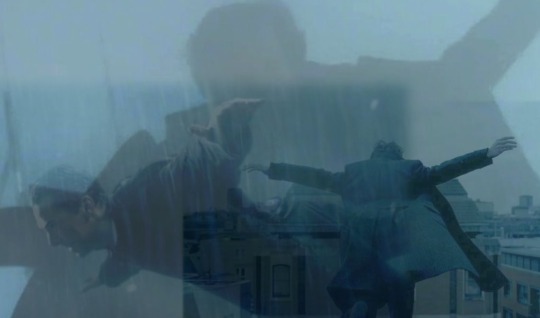
Considering the fact that the creators of Sherlock BBC obviously enjoy playing with names, words, double meanings and innuendos really very much, I seriously wonder wether there is a reason behind the decision to dress John Watson in his, by now, famous oatmeal coloured jumper or let Sherlock tell a room full of wedding guests that he ‘could go on all night about the depth and complexity of (John’s) ... jumpers ...’
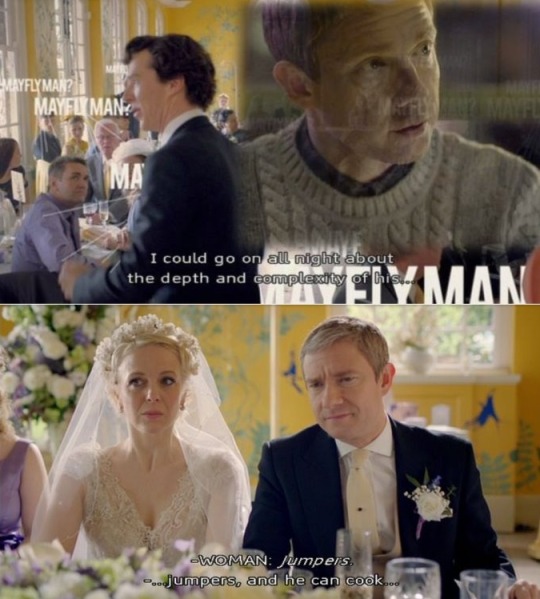
PS: Taking the screen caps from the wedding, I noticed for the first time that a female voice says ‘jumpers’ simultaneously with Sherlock in this scene. It’s a bit like Mrs. Hudson suddenly chiming in with ‘softer, Sherlock’ during his conversation with Molly in TFP.
The Christmas jumpers shouldn’t be forgotten either. There are two of them which play a role in Sherlock BBC: John wears one in ASIB, the other one turns up in the fisherman deduction scene in THOB. @sagestreet wrote about the fisherman and his mother here. By the way … that’s most likely a reindeer on the fisherman’s jumper. Reindeer’s are a species of deer and deer, stags and harts are another heavy featured topic in this story.
(Sherlock the stag and the skull Stalking the deerstalker The three Garridebs Study in pink and green)

Change of colour
Also interesting … due to its L-shaped movement, a knight, beginning on a white square, will always end up on a black square, and vice versa. The colour of the square it stands on, changes with each movement. Changing is definitely another main theme - if not THE main theme - of this story.
Short version for the transformation from Rosie to rainbow: Rosamund=rose of the world=rosa mundi=rosa versicolor=changing colours/many colours/iridescence=rainbow
(longer version in these comments The elephant in the room/womb Prism)
Back to the game and the knights
Looking at the chess pieces on the board and the captured ones lying next to it, one can safely say that it had been Mycroft who started this game, because according to the rules of chess, white moves fist.

If Sherlock BBC is meant to be a great, metaphorical game of chess, with the various characters serving as chess pieces, then Mycroft starting that game, would coincide with a PILOT starting point. Before John Watson walks into the lab at Bart’s Hospital and meets Sherlock Holmes for the first time, before DI Lestrade summons Sherlock to the crime scene of the Lady in Pink, it is Mycroft who sends Sherlock an E-Mail, asking for his help in an ‘impossible situation’. Sherlock answers his brother with the famous Holmes quote from canon:
‘When you have eliminated the impossible whatever remains must be the truth. ‘

This interpretation would also coincide with the idea that in this story Mycroft represents the brain, Sherlock’s brain. Logic, reason and intellect. After all, it is this organ which starts every movement and every thought in everyones life. (The reptile in 221b)
It is Mycroft who first kidnaps and investigates the ‘eternal friend’ - Sherlock’s feelings for John. In the wake of the first explosion, it is him who brings the ‘West' case to Baker Street, who later downright forces Sherlock to take the ‘Woman-case’. It is him who releases the ‘Hound’ and also him who brings Sherlock back from the dungeon inside the forest. Jim becomes Eurus’ Chrismas present because ‘big brother’ allowed it. Mycroft is responsible that Sherlock gets involved in the Carmichael case and it is also him who tells Sherlock that ‘We don’t defeat them (emotions). We must certainly lose to them. Because they are right, and we are wrong.’ This case leads Sherlock to his very own Reichenbach Falls - ‘the greatest crisis of my career’ - the point where he throws himself into the waterfall, out of his own free will. No one forces him, there is not the slightest need to do this. Yet Sherlock jumps and flies.
Centre stage for the knights …. the jumpers ….
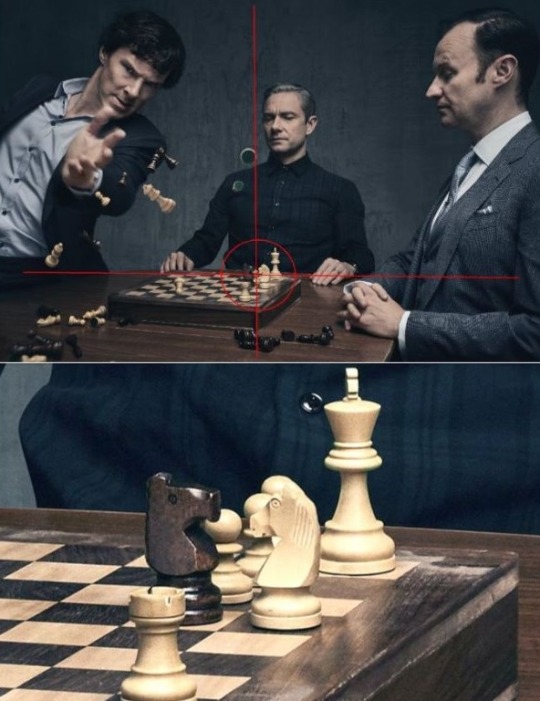
Henry Knight instead of Henry Baskerville …. it seems there could have been a lot of good reasons for the creators of Sherlock BBC to choose KNIGHT as the new surname for … THE Baskerville … the man haunted by demons.

(Shoes for the hound Investigator of secrets and scandals)
Source of chess info/pics (x x x), source of Sherlock BBC chess promo pics (x)
I leave you to your own deductions. Thanks @callie-ariane for the scripts.
October, 2019
42 notes
·
View notes
Text
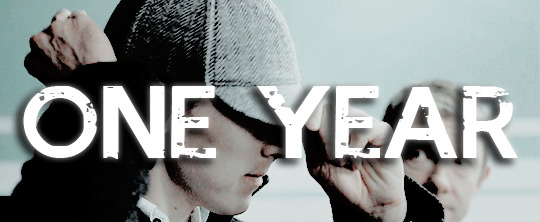
It's my first blogiversary! Okay, I’m a little late, I actually made this blog on April 1st, but this post isn’t something for Fool’s Day. I made this blog on April Fool’s Day as a literal joke thinking that I’d abandon it in two weeks, if not sooner, but it’s kept up (somehow) for a year now. Even though sometimes I have other things going on in life, I always try to come back to this blog because I’ve grown so much in my writing & adore writing with all of you! I hope this blog survives a few more years, but thanks to everyone who has ever written with me (now and through the very poor writing I started with), plotted with me, &/or talked to me (period, sometimes I’m a lonely soul). x
CLIENTS (in alphabetical order) -- these are people, old and new, who I love to talk to, plot with, & see on my dash! Some of these people I know incredibly well & others I’ve only talked to a few times, but no matter the case, I greatly admire to them & they have positively impacted my time in the rp community. Honestly, this is just a few of them too, because it’s way too hard to tag every single mun I’ve written with, so I may have missed a few.
@akasupergirl / @wearenotthesameasyesterday | @amanandgoodatit | @consultingsister | @feminaadler | @governmentofficial | @harknesstm | @jemmaagentofshield | @londontigress | @manynarrators | @mollythepathologist | @narrativecrime | @notyouraveragesecretary | @obituarics | @ofmagicandpcwer | @patiencetaught | @plantagenetking | @poxsonmenace | @rwtsn | @spidcrwomen | @venosum | @vxctorx | @watsonofagun | @wonwars | @wtsns
ADDRESS BOOK -- some of you may recall that Sherlock has a rather bare address book, but he does keep some of his good friends in there. These are people who deserve awards for dealing with me so much. I absolutely adore them & because I put them in the ‘address book”, yes, these are the people who I would fake my death for.
@thewxman
Sophie, let me reiterate our IMs, I bloody L O V E you. I love your portrayal of Irene & I especially love the chemistry between our muses. Honestly, Sherl’s never been so in love until he met your Irene. Thank you SO much for screaming with me in our IMs, doting on our children, making me a better writer (rise up!), & reviving my dead muse so many times over. Also those texting threads in our IMs actually make my day-- they’re just so pure??? AND ALL THE BLOODY LETTERS. That was one of my favourite threads ever. Dropping those subtle (or not so subtle) Hamilton references on the adlock yacht. This is getting long, so I’ll just end it with this-- Sophie, I like you a lot <3
@eloquated
Britt, it’s been way too long & I’m well aware that you’ve stopped rping (or at least put it on pause), but we plotted for FOREVER together so I can’t just leave you out of this. I adore you so very much & I’ll honest that I was iffy about my Sherlock ever falling for a Molly until he met yours. Also, Britt, I was so in awe of your character development (esp Mycie’s)! Thank you for plotting every detail in our long novella threads (the future sherlolly children’s middle names, even) & inspiring me so much (with your lovely edits), I miss you! ( @sherlockrarepairs )
@braveheart-watson / @ironifiicd / @thelegendofemrys
SHURLEY-- wow, what would this post be without my sin bin friend? I miss writing with you so much, but I know that you have a million blogs, so I’ll wait patiently for the John muse to resurrect. I love talking to you about our sons (& how badass Mary Watson was, especially), I love that we once had a conversation in all Chuck Shurley gifs, & I love your undying Canadian patriotism. Thank you for writing IMMENSE amounts of angst with me & dragging me (kicking & screaming) into the sin bin with you.
@crownjeweledspider
Tori, you’ve been with me since the very start. You’ve somehow stuck with me this long even with my rubbish writing & flaky muse. Gemlock was the very first invested ship I had on this blog & a part of my Sherl will always love your Gemma. Between our random muse vc to our randomly dark convos (with our terribly morbid senses of humour), I love talking to you. <3 you so much other half of lyri -squeeze- ( @bxnnxrxd )
#♩♫ spectacularly ignorant ⇒ ooc#long post tw#[[ i love all of my followers & mutuals. thank you all! ]]#thewxman#crownjeweledspider#braveheart-watson#eloquated
23 notes
·
View notes
Note
Out of curiosity, what made you stop shopping J*hnlock? Or at least, stop hardcore shipping it?
(I’m beginning to feel more social and just got this ask, so might as well answer it, because it’s anon and easy.)
I think the iceberg that sunk my ship was ASiB. It was kind of the combination of Sherlock’s feelings for Irene and John’s constant, vehement denial of being gay, even after the “it’s all fine” thing in the very first episode. I just didn’t feel the ship as much, and I didn’t see the same chemistry overall as Series 1. I read some post-TRF fic, and probably didn’t totally stop reading J*lock fic until about 2013 (when I just stopped reading Sherlock fic altogether for a few years). And I mean, I could even see some moments through shipper goggles in S3, but by then I wasn’t invested enough to look for fic. I have since read a few John-Mary-Sherlock (Johnlockary? I think) fics, and they were good, but not nearly as meaty as I was hoping for.
And of course, Sustain did a lot to convert me to Sherlock x Molly as a pairing (back in ye olden days before these awful ship names, which I will never like or even get used to). Before that, it was something I wanted, but I had a hard time seeing how it would work (with the S1 characters, at least, and in a meaningful, thoughtful way, not just porn one-shots). Don’t forget, we only had three episodes of content to work with for characterization. maybe_amanda and onemillionandnine did the legwork needed to build that bridge for me.
Even now, I’m not opposed to the idea of J*lock, but I don’t bother seeking it out because of how toxic the entire fandom turned (and, while it was mostly one group being awful, I saw a lot of awfulness from all sides, which turned me off to a lot more than just that one ship). And after TFP, I can’t see anything without Molly at least being one leg of a triad. Which I might or might not read (if it exists), because I have complicated feelings about polyamory stemming from my own experiences and those of people I know, so I have a hard time seeing that kind of arrangement as long-term healthy and a happily ever after. I mean, I’d like to read something like that if it were well done, and have given a lot of thought to how I would do it while I was working on Perfect, Not Perfect-Perfect, but nothing ever came of it (shock!).
I still ship the hell out of ACD/ Grenada Holmes and Watson, though. In fact, if anyone has any good recs for non-BBC fic, I’ll take them. I really should have bookmarked/ saved some of my old favorites because I don’t remember titles any more and I think some of the porn has completely disappeared. I remember one that was the origin story and I think it was from Holmes’ POV, and Watson was very blonde; I don’t remember anything else, sadly.
Anyway, yeah. I do still miss the way I felt about the ship and the whole fandom scene from back in 2010/11, but nothing gold can stay. So yeah.
#from an ask#all about my ships#i don't want to tag it j-lock because i don't want it in their tag#sorry
14 notes
·
View notes
Note
FYI: A Case for Johnlock: Why SHERLOCK Should Embrace Its Ship of Dreams | ScreenSpy
Thank you!
Article link…
A Case for Johnlock: Why SHERLOCK Should Embrace Its Ship of Dreams - By Chris. B
Modern television has more “ships” than the Pacific Ocean. Virtually every character on the airwaves has been matched with another, fancied relationships dreamed up by eager fans, either to generate laughs or to satisfy personal passions. Every fandom has its favorite pairs, but if you’re a follower of the BBC’s Sherlock, the most discussed coupling by far is that John and Sherlock, or Johnlock. The desire to see these two together in more than a simple platonic friendship is one that is played out in blogs and fan fiction regularly, but is this something fans will ever see developed on screen?
There are many factors to consider here. Sadly, in 2017, there is still a certain amount of controversy about showing a gay couple in an everyday relationship, one that is not present for purposes of comic relief or sideline plot support. Would the network and affiliates allow it? How conservative are its politics and those of its advertisers? Given the overwhelming popularity of the show on an international scale, I would wager their wallets would easily trump any qualms that might exist. It is amazing how capitalism can solve all manner of perceived ills.
Regardless, do Mark Gatiss and Steven Moffat even want this to be the dynamic of their characters? According to them, the answer is no. In an interview with Valerie Parker in July of last year, Gatiss claimed, “…we’ve explicitly said this is not going to happen – there is no game plan – no matter how much we lie about other things, that this show is going to culminate in Martin and Benedict going off into the sunset together. They are not going to do it.”
That sounds pretty final. Maybe.
Since these two have made the most of The X-Files philosophy that a lie is most conveniently hidden between two truths, there is always room for doubt. (Really, how likely is it that a seasoned professional like Gatiss suddenly mistook the names of his characters for those of the men who portray them?)
In any case, I think an openly romantic relationship between John and Sherlock would be well worth it. Consider the following points and determine for yourself if this match is a just a forgettable fantasy, or if it could be an ultimate destiny.
5. The characters are already tightly bonded
No one would argue with the idea that Sir Arthur Conan Doyle’s original characters of Holmes and Watson are best friends; through each of the numerous variations presented over the intervening century plus, this is one of the few facets has remained consistent. They are a team. Individually, though, each member of the team is lacking. At one point, Sherlock confesses in “The Great Game” that he’s been “reliably informed” that he has no heart, going so far as to declare several different times that he is a high-functioning sociopath. John, on the other hand, is “abnormally attracted to dangerous situations and people”; he misses the war that left him behind. Both have a hole that they need to fill, and that is exactly what the other satisfies.
In Sherlock, this is reinforced repeatedly. John and Sherlock are clearly presented as two halves of the same whole, each needing the other to be a complete version of himself—John, the heart and inspiration; Sherlock, the excitement and intellectual challenge. When Sherlock is baffled why a woman would be upset about her child’s death after fourteen years or when he too gleefully investigates a child kidnapping, John is there to mediate his reactions. Then, when Sherlock returns in “The Empty Hearse,” he insists correctly of John, “You have missed this…the thrill of the chase, the blood pumping through your veins, the two of us against the rest of the world.” Later, in “The Abominable Bride,” John quips to Moriarty, “There are always two of us.” There must be. Inevitably, all roads they take lead to Baker Street, back to their roots together.
4. There is already plenty of precedent for it
Sherlock has never shied away from the suggestion that Sherlock and John are more than friends. From the outset, John is mistaken for Sherlock’s date, and the man who will “outlive God trying to have the last word” makes no correction, nor does he when a reporter in “The Reichenbach Fall” asks for a quote about whether he and Dr. Watson are “strictly platonic.” Further, the two gay owners of The Cross Keys Inn from “The Hounds of Baskerville” assess John and Sherlock as a pair; and Mrs. Hudson, who lives just a floor below them and knows them very well, refers to one of their arguments as “a little domestic” and is shocked when John is ready to move on (to marry a woman?) a full two years after Sherlock’s supposed death. Then, Irene Adler, who sizes people up as adeptly as Sherlock, calls out John’s jealousy about the 57 unanswered texts that she’s sent (yes, John kept track) and flatly counters John’s insistence that he and Sherlock are a couple: “Yes, you are.” Finally, in “The Abominable Bride,” when John saves his other half from the precipice and Sherlock gushes about John’s intelligence, Moriarty himself rolls his eyes and scoffs, “Oh, why don’t you two just elope, for God’s sake!”
There are innumerable instances of extreme devotion shown to us as well. In “His Last Vow” Sherlock literally restarts his own heart because John is in danger, then commits murder to protect John from the thumb of Magnussen’s extortion. In “The Great Game” John throws himself on Moriarty to allow Sherlock to escape the bomb he wears, and in “A Scandal in Belgravia,” he dumps his girlfriend and their holiday plans to stay home and look after Sherlock, a choice he makes easily after she demands, “Don’t make me compete with Sherlock Holmes!” (Oh, he won’t, dear; there’s no contest.) Further, images abound of the intense and meaningful stares shared by these two, traded like stocks on internet forums and social media, all screaming of something bubbling beneath the surface. Thus, to transition to an official couple would not be much of a stretch.
3. It fits the transformational model of the show
Gatiss and Moffat have shown a penchant for pushing the envelope with their version of Doyle’s characters. Would Doyle have raised his eyebrows over John’s sibling being a divorced lesbian who’s taken to drink? I doubt the original author could have imagined Mrs. Hudson as a former exotic dancer who had been married to the head of a drug cartel. And certainly no one anticipated that the lovable Mary Morstan would turn out to be a former intelligence agent and ruthless trained assassin.
The creators have not been afraid to add their own special spice to these characters. In a 2014 interview with Phil Ittner, Gatiss and Moffat asserted, “Most of [the series] is actually completely new, so there’s not a drying-up of the source…we’re slightly broadening out the world a bit and being slightly more heretical than we probably would have been at the beginning. But then that’s good, it feels like this is our version…” To go all-in and apex this concept with the core pair would allow them to make a truly indelible mark on the enormous canon of Sherlock Holmes iterations.
After all, side characters are only so revealing; in this universe, John and Sherlock are the only ones who matter. The series has been proposed as the story of the development of a genius, hence its very specific title, so building Sherlock Holmes to the point where he can freely give and receive love, achieving true intimacy, would be the greatest development possible. Gatiss and Moffat could provide that humanity for him, to create their own warm center to the notoriously melancholy sphere of the private life of the world’s only consulting detective.
2. Proper representation matters
All segments of society can and should have a right to see themselves recognized unabashedly by the media they consume, whether it is fiction or non-fiction. In the twenty-first century, this should not still be the struggle that it is, yet any in the LBGTQ community know how resistant this practice is to change in the machine of social institutions. Too often, gay characters are used as statue pieces or comic relief, sidelines or after thoughts; they are not permitted to be real and valuable human beings, but are stock characters and stereotypes, extras who inevitably get the axe if the Grim Reaper comes calling.
Steven Moffat has been most emphatic on the issue that the showing of gay or bisexual characters in popular culture should not be approached with triviality, that it is a serious issue that should be offered (particularly to young people) in a way that denotes true acceptance. In his Parker interview, he asserted, “You don’t want to essentially tell children that [being gay is] something to campaign about. You want to say this is absolutely fine and normal. There is no question to answer. You want to walk right past it, in a way. You don’t want to…say, as sometimes other kinds of literature or movies might, we forgive you for being gay. You’re just saying you’re gay and it doesn’t matter. There’s no issue.”
Essentially, one’s sexuality is just an average, marginally interesting, non-personality-defining, run-of-the-mill reality. Thus, no matter what your sexual bent, it is not odd; it is not special or different, wonderful or terrible. It just is, as mundane to one’s whole character as eye color or shoe size. Indeed, until this matter does not flutter pulses with its rakish novelty, true acceptance has not yet occurred. Having Sherlock and John integrate their sexuality seamlessly into the roster of the other attributes that the audience has witnessed, to roll it into the entire picture of who they are, we would be granted a relaxed and genuine portrayal of a devoted couple that happens to be gay, one from which we could all ultimately benefit.
1. It would count Sherlock is a global phenomenon.
According to the Radio Times, it is shown in 224 countries and territories around the world, making it the most watched of any of the BBC’s programs, surpassing even Dr. Who, which has decades of history. It has spawned blogs and merchandise and a number of Sherlocked fan events, which are major affairs to rival the most popular comic cons, where every artifact, set detail, and image from the show is cherished and applauded.
The series’ leads, Benedict Cumberbatch and Martin Freeman, are beloved international stars. Thanks in no small part to this show, they are in constant demand and headline massive studio projects, like The Hobbit series of films and Marvel’s Dr. Strange. Each has a immense following of fans, and rightly so—they are award-winning craftsmen, extremely versatile talents who deserve every bit of success they’ve acquired.
This degree of influence and appeal leverages a lot of power.
What this show brings to the table, the world eats; what it points to as its guides, people would notice, and what’s more, follow. What, then, could be accomplished in social terms if Sherlock were to subtly demystify gay relationships? What might result if a stellar product and the highly popular individuals involved indicate that a homosexual relationship is every bit as complicated and trying and boring and wonderful as every other kind?
Respect. And with luck, progress.
Thanks, Chris. B
2K notes
·
View notes
Text
redbuttonhole replied to your post: I know there’s so much not so well hidden wank...
I feel bad that I’m not more active in the femslash side of sherlock fandom, but I had no idea what ship you were talking about originally, and I still don’t. :(
Aaw, don’t feel bad :) Time is not an infinite resource and we can’t do all at once. I will say though: Femslash February is coming up soon and it’s a wonderful time to try new things!
As for what ship I’m referring to: Molly Hooper x Stella Hopkins.
The wank part I’ll put under the cut. You might have drawn all the conclusions you need already, but the more I think about it, the more I need to actually type it out.
Anyway.
So after the first promo pic of Eleanor Matsuura as D.I. Hopkins was released in December there was an explosion of fanworks created shipping her with Molly Hooper. Which is awesome! It really is! All femslash in this fandom is sooo welcomed I can’t even begin to tell you.
What left a bitter taste in my mouth about the whole thing was all of the “look at these lesbians clearly being lesbians” and “finally a lesbian couple to ship” comments and sentiments surrounding the ship. This, in part, because Molly isn’t a lesbian (even if you ignore the reading that she’s in love with Sherlock, she still dates two men openly), but mostly because there are so many amazing femslash ships in this fandom that it becomes ridiculous to say that a promopic has more of a connection to a character than actual character (some of which have even interacted on screen). This sudden rush to ship Molly with D.I. Hopkins (we didn’t even know her first name at this point) clearly wasn’t sprung from some amazing chemistry they had in the show.
Neither was it for the want to just See More Femslash (something I support any day of the week!) because none of these people have ever cared for any femslash ship before, ever. Or at least not created anything for any of them. Femslash blog mod, you sort of start to notice people. There are so many amazing femslash ship in this fandom and if people were so desperate for a femslash ship Irene Adler/Molly Hooper (the biggest femslash ship in this fandom) has been a thing since A Study in Belgravia aired. Anthea/Molly, Anthea/Sally and Molly/Sally dates back to series 1. And series 3 gave us the amazing Janine/Mary. The ships are there, and they are awesome, and they are slowly dying. All. Of. Them.
Still, if it was the representation of wlw ships, there were plenty to choose from.
(I’m not even going to dwell on the fact that the most common shipname for this ship is a shipname ALREADY USED BY A DIFFERENT FEMSLASH SHIP! which people would have noticed had they just bothered to actually look at the femslash part of the fandom.)
Add to this that from time to time there is wank crossing my dash about how Molly Is A Lesbian #givemollyagirlfriend and that shipping her with Sherlock is homophobic and wrong #mollydeservesbetter (no, those are not real tags) with the rebuttal from sherlollians in the form of “if you really think that, why is the only time you say it when you shit all over our ship?”
Suddenly, all the wonderful new fanworks start to get... uncomfortable because it doesn’t take much to make the leap that this sudden influx of femslash is an attempt to be able to point at something and say “Your argument is invalid. Look! I’m creating femslash. I’m not a misogynist, but you’re still a homophobe.” It doesn’t take much to see the newest femslash ship in the fandom not just being used as a weapon in a shipwar, but being created solely for that purpose.
And honestly, all female characters deserve better than that!
Still, as I said in the first post, I enjoyed the shit out of that short spur of femslash creativity, no matter what drove it and I welcome the ship! And Stella Hopkins. I think I need to write something about her, Anthea and Sally for polyshipping day.
2 notes
·
View notes
Photo
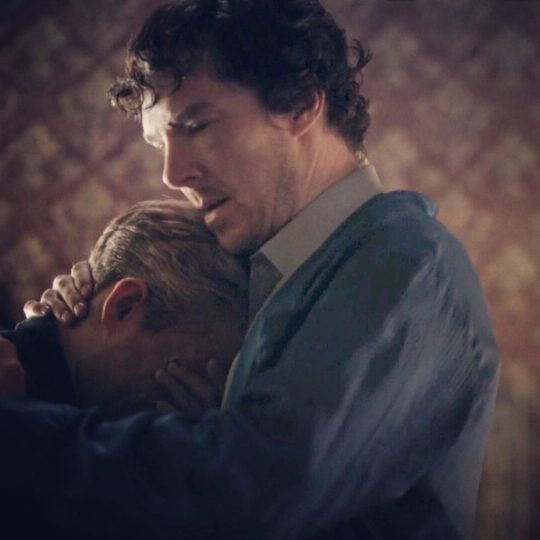
Why SHERLOCK Should Embrace Its Ship of Dreams
By The Screen Spy Team on January 10, 2017 By Chris B.
Modern television has more “ships” than the Pacific Ocean. Virtually every character on the airwaves has been matched with another, fancied relationships dreamed up by eager fans, either to generate laughs or to satisfy personal passions. Every fandom has its favorite pairs, but if you’re a follower of the BBC’s Sherlock, the most discussed coupling by far is that John and Sherlock, or Johnlock. The desire to see these two together in more than a simple platonic friendship is one that is played out in blogs and fan fiction regularly, but is this something fans will ever see developed on screen? There are many factors to consider here. Sadly, in 2017, there is still a certain amount of controversy about showing a gay couple in an everyday relationship, one that is not present for purposes of comic relief or sideline plot support. Would the network and affiliates allow it? How conservative are its politics and those of its advertisers? Given the overwhelming popularity of the show on an international scale, I would wager their wallets would easily trump any qualms that might exist. It is amazing how capitalism can solve all manner of perceived ills. Regardless, do Mark Gatiss and Steven Moffat even want this to be the dynamic of their characters? According to them, the answer is no. In an interview with Valerie Parker in July of last year, Gatiss claimed, “…we’ve explicitly said this is not going to happen – there is no game plan – no matter how much we lie about other things, that this show is going to culminate in Martin and Benedict going off into the sunset together. They are not going to do it.” That sounds pretty final. Maybe. Since these two have made the most of The X-Files philosophy that a lie is most conveniently hidden between two truths, there is always room for doubt. (Really, how likely is it that a seasoned professional like Gatiss suddenly mistook the names of his characters for those of the men who portray them?) In any case, I think an openly romantic relationship between John and Sherlock would be well worth it. Consider the following points and determine for yourself if this match is a just a forgettable fantasy, or if it could be an ultimate destiny.
5. The characters are already tightly bonded No one would argue with the idea that Sir Arthur Conan Doyle’s original characters of Holmes and Watson are best friends; through each of the numerous variations presented over the intervening century plus, this is one of the few facets has remained consistent. They are a team. Individually, though, each member of the team is lacking. At one point, Sherlock confesses in “The Great Game” that he’s been “reliably informed” that he has no heart, going so far as to declare several different times that he is a high-functioning sociopath. John, on the other hand, is “abnormally attracted to dangerous situations and people”; he misses the war that left him behind. Both have a hole that they need to fill, and that is exactly what the other satisfies. In Sherlock, this is reinforced repeatedly. John and Sherlock are clearly presented as two halves of the same whole, each needing the other to be a complete version of himself—John, the heart and inspiration; Sherlock, the excitement and intellectual challenge. When Sherlock is baffled why a woman would be upset about her child’s death after fourteen years or when he too gleefully investigates a child kidnapping, John is there to mediate his reactions. Then, when Sherlock returns in “The Empty Hearse,” he insists correctly of John, “You have missed this…the thrill of the chase, the blood pumping through your veins, the two of us against the rest of the world.” Later, in “The Abominable Bride,” John quips to Moriarty, “There are always two of us.” There must be. Inevitably, all roads they take lead to Baker Street, back to their roots together.
4. There is already plenty of precedent for it Sherlock has never shied away from the suggestion that Sherlock and John are more than friends. From the outset, John is mistaken for Sherlock’s date, and the man who will “outlive God trying to have the last word” makes no correction, nor does he when a reporter in “The Reichenbach Fall” asks for a quote about whether he and Dr. Watson are “strictly platonic.” Further, the two gay owners of The Cross Keys Inn from “The Hounds of Baskerville” assess John and Sherlock as a pair; and Mrs. Hudson, who lives just a floor below them and knows them very well, refers to one of their arguments as “a little domestic” and is shocked when John is ready to move on (to marry a woman?) a full two years after Sherlock’s supposed death. Then, Irene Adler, who sizes people up as adeptly as Sherlock, calls out John’s jealousy about the 57 unanswered texts that she’s sent (yes, John kept track) and flatly counters John’s insistence that he and Sherlock are a couple: “Yes, you are.” Finally, in “The Abominable Bride,” when John saves his other half from the precipice and Sherlock gushes about John’s intelligence, Moriarty himself rolls his eyes and scoffs, “Oh, why don’t you two just elope, for God’s sake!” There are innumerable instances of extreme devotion shown to us as well. In “His Last Vow” Sherlock literally restarts his own heart because John is in danger, then commits murder to protect John from the thumb of Magnussen’s extortion. In “The Great Game” John throws himself on Moriarty to allow Sherlock to escape the bomb he wears, and in “A Scandal in Belgravia,” he dumps his girlfriend and their holiday plans to stay home and look after Sherlock, a choice he makes easily after she demands, “Don’t make me compete with Sherlock Holmes!” (Oh, he won’t, dear; there’s no contest.) Further, images abound of the intense and meaningful stares shared by these two, traded like stocks on internet forums and social media, all screaming of something bubbling beneath the surface. Thus, to transition to an official couple would not be much of a stretch.
3. It fits the transformational model of the show Gatiss and Moffat have shown a penchant for pushing the envelope with their version of Doyle’s characters. Would Doyle have raised his eyebrows over John’s sibling being a divorced lesbian who’s taken to drink? I doubt the original author could have imagined Mrs. Hudson as a former exotic dancer who had been married to the head of a drug cartel. And certainly no one anticipated that the lovable Mary Morstan would turn out to be a former intelligence agent and ruthless trained assassin. The creators have not been afraid to add their own special spice to these characters. In a 2014 interview with Phil Ittner, Gatiss and Moffat asserted, “Most of [the series] is actually completely new, so there’s not a drying-up of the source…we’re slightly broadening out the world a bit and being slightly more heretical than we probably would have been at the beginning. But then that’s good, it feels like this is our version…” To go all-in and apex this concept with the core pair would allow them to make a truly indelible mark on the enormous canon of Sherlock Holmes iterations. After all, side characters are only so revealing; in this universe, John and Sherlock are the only ones who matter. The series has been proposed as the story of the development of a genius, hence its very specific title, so building Sherlock Holmes to the point where he can freely give and receive love, achieving true intimacy, would be the greatest development possible. Gatiss and Moffat could provide that humanity for him, to create their own warm center to the notoriously melancholy sphere of the private life of the world’s only consulting detective.
2. Proper representation matters All segments of society can and should have a right to see themselves recognized unabashedly by the media they consume, whether it is fiction or non-fiction. In the twenty-first century, this should not still be the struggle that it is, yet any in the LBGTQ community know how resistant this practice is to change in the machine of social institutions. Too often, gay characters are used as statue pieces or comic relief, sidelines or after thoughts; they are not permitted to be real and valuable human beings, but are stock characters and stereotypes, extras who inevitably get the axe if the Grim Reaper comes calling. Steven Moffat has been most emphatic on the issue that the showing of gay or bisexual characters in popular culture should not be approached with triviality, that it is a serious issue that should be offered (particularly to young people) in a way that denotes true acceptance. In his Parker interview, he asserted, “You don’t want to essentially tell children that [being gay is] something to campaign about. You want to say this is absolutely fine and normal. There is no question to answer. You want to walk right past it, in a way. You don’t want to…say, as sometimes other kinds of literature or movies might, we forgive you for being gay. You’re just saying you’re gay and it doesn’t matter. There’s no issue.” Essentially, one’s sexuality is just an average, marginally interesting, non-personality-defining, run-of-the-mill reality. Thus, no matter what your sexual bent, it is not odd; it is not special or different, wonderful or terrible. It just is, as mundane to one’s whole character as eye color or shoe size. Indeed, until this matter does not flutter pulses with its rakish novelty, true acceptance has not yet occurred. Having Sherlock and John integrate their sexuality seamlessly into the roster of the other attributes that the audience has witnessed, to roll it into the entire picture of who they are, we would be granted a relaxed and genuine portrayal of a devoted couple that happens to be gay, one from which we could all ultimately benefit.
1. It would count Sherlock is a global phenomenon. According to the Radio Times, it is shown in 224 countries and territories around the world, making it the most watched of any of the BBC’s programs, surpassing even Dr. Who, which has decades of history. It has spawned blogs and merchandise and a number of Sherlocked fan events, which are major affairs to rival the most popular comic cons, where every artifact, set detail, and image from the show is cherished and applauded. The series’ leads, Benedict Cumberbatch and Martin Freeman, are beloved international stars. Thanks in no small part to this show, they are in constant demand and headline massive studio projects, like The Hobbit series of films and Marvel’s Dr. Strange. Each has a immense following of fans, and rightly so—they are award-winning craftsmen, extremely versatile talents who deserve every bit of success they’ve acquired. This degree of influence and appeal leverages a lot of power. What this show brings to the table, the world eats; what it points to as its guides, people would notice, and what’s more, follow. What, then, could be accomplished in social terms if Sherlock were to subtly demystify gay relationships? What might result if a stellar product and the highly popular individuals involved indicate that a homosexual relationship is every bit as complicated and trying and boring and wonderful as every other kind?
Respect. And with luck, progress.
(via A Case for Johnlock: Why SHERLOCK Should Embrace Its Ship of Dreams)
5 notes
·
View notes